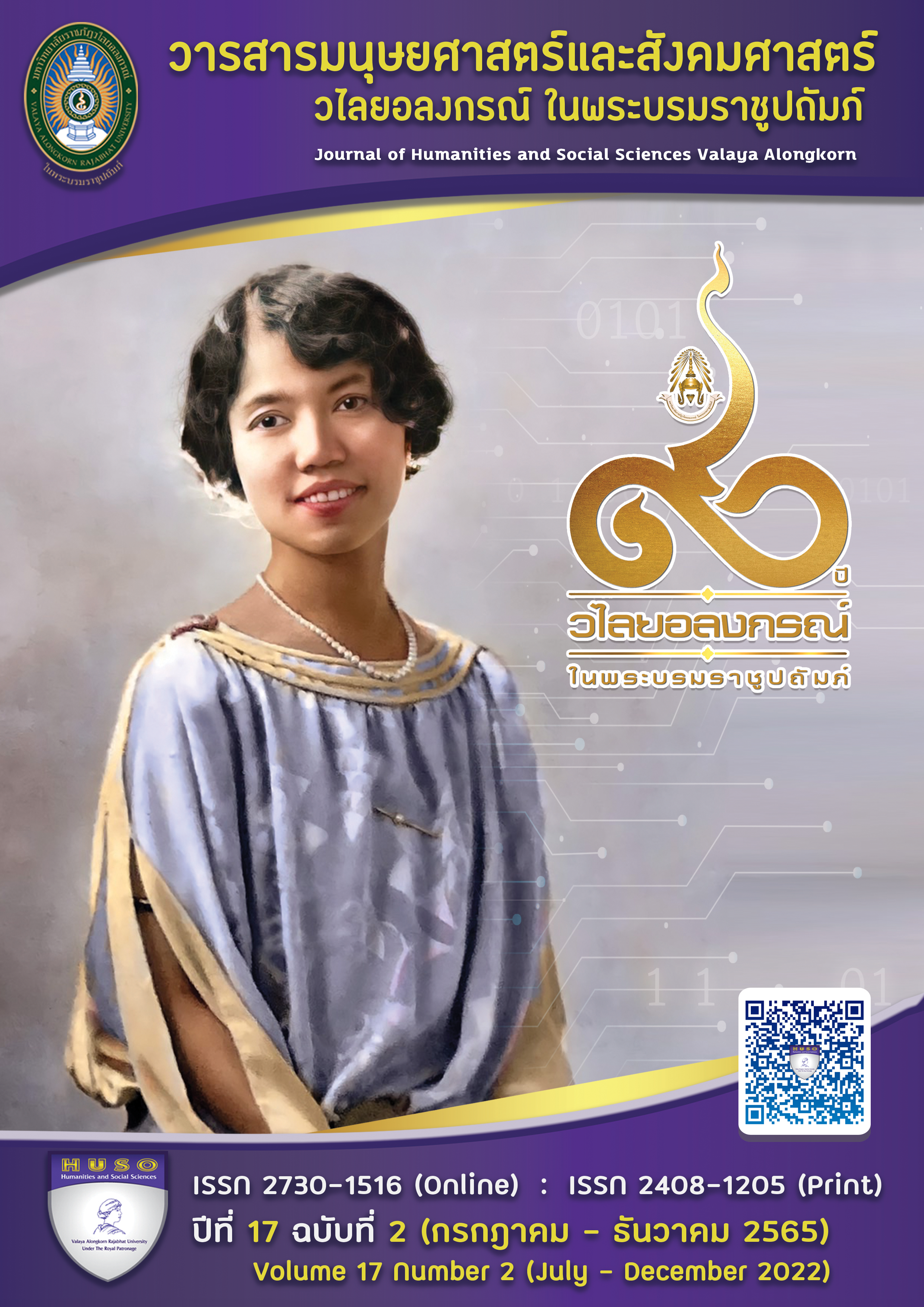SCIENCE AND UTOPIAN IDEAS APPEARING IN THE SCIENCE FICTION STORY NAKORN LOHA NAO
Main Article Content
Abstract
This academic article is the study of the science fiction story Nakhon Loha Nao,by Nan Nanthakhun. The purpose of the study was to examine the scientific and utopian characteristics found in the story. The results showed that this fiction has many scientific characteristics including food technology, transportation, sports, entertainment, communication technology and medical technology advancements which are all present in the daily lives of the people in Masburi City. The Utopian characteristics of Nakhon Loha Nao show that there is no conflict between the people and technology. The people in the story use Buddhism as a guideline for life. and are governed by democratic principles and equality.
Article Details

This work is licensed under a Creative Commons Attribution-NonCommercial-NoDerivatives 4.0 International License.
ลิขสิทธิ์บทความวิจัยที่ได้รับการตีพิมพ์เผยแพร่ในวารสารมนุษยศาสตร์และสังคมศาสตร์ วไลยอลงกรณ์ ในพระบรมราชูปถัมภ์ ถือเป็นกรรมสิทธิ์ของคณะมนุษยศาสตร์และสังคมศาสตร์ มหาวิทยาลัยราชภัฏวไลยอลงกรณ์ ในพระบรมราชูปถัมภ์ ห้ามนำข้อความทั้งหมดหรือบางส่วนไปพิมพ์ซ้ำ เว้นแต่จะได้รับอนุญาตจากมหาวิทยาลัยเป็นลายลักษณ์อักษร
ความรับผิดชอบ เนื้อหาต้นฉบับที่ปรากฏในวารสารมนุษยศาสตร์และสังคมศาสตร์ วไลยอลงกรณ์ ในพระบรมราชูปถัมภ์ เป็นความรับผิดชอบของผู้นิพนธ์บทความหรือผู้เขียนเอง ทั้งนี้ไม่รวมความผิดพลาดอันเกิดจากเทคนิคการพิมพ์
References
ชมรมนิยายวิทยาศาสตร์ไทย. (ม.ป.ป.). นิยายวิทยาศาสตร์ สำคัญอย่างไร. http://thaiscifi.izzisoft.com
ชัยวัฒน์ คุประตกุล. (2555, 30 มกราคม). พัฒนาการและแนวเรื่องของนิยายวิทยาศาสตร์.
http://thaiscifi.izzisoft.com/%
นันท์ นันทคุณ. (2533). นครโลหะหนาว. (พิมพ์ครั้งที่ 2). กรุงเทพฯ: วี.ดี.พี.กรุ๊ฟ.
พระมหาสากล สุภรเมธี และคณะ. (2564). สังคมอุดมคติตามหลักพุทธปรัชญา. วารสารวนัมฏองแหรก
พุทธิศาสตร์ปริทรรศน์, 8(2), 87-102.
ยงยุทธ ยุทธวงศ์. (2559). เสี้ยวบทสนทนานิรันดร์. กรุงเทพฯ: นานมีบุ๊คส์.
ศุภวรรณ ศรีจันทร์. (2556, 31 มกราคม). จากฮีเลี่ยมเหลวหยดแรก...สู่ความก้าวหน้าทางวิทยาศาสตร์.
https://www.slri.or.th/th/slridevelop/2013-01-31-03-49-54.html
สำนักงานราชบัณฑิตยสภา. (2554, 3 พฤศจิกายน). พจนานุกรมฉบับราชบัณฑิตยสถาน พ.ศ 2554.
https://dictionary.orst.go.th/
สุรเดช โชติอุดมพันธ์. (2561). A Little History of Literature [วรรณกรรมประวัติศาสตร์ เรื่องเล่าแห่ง จินตนาการ]. บุ๊คสแคป.
อัจฉรา ชลายนนาวิน. (2559). ยูโทเปีย : มิติทางสังคมศาสตร์. วารสารด้านการบริหารรัฐกิจและการเมือง,
(2),1-28.
Chalayonnavin, A. (2016). Utopia: [Utopia: It’s Dimensions in Social Science]. Journal of Public Administration and Politics. (July- December), 1-28.
Chotiudompant, S. (2018). Wannakamprawattisat runglaohangchintanakarn. [A Little History of Literature]. Bangkok: Bookscape.
Subharamedhi, P. et al. (2021). Sangkomudomkati Tamlakbuddapratchaya. [The ideal according to the buddhist philosophy principle]. Journal of Buddhist Studiest Studies Vanam Dongrak. 8(2), 87-102.
Kupratakul, C. (2012). Pattanakarn lae neawruang khong nawaniyay wittayasart [Development and subject matter of science fiction]. Retrieved April 27, 2021. formhttps://thaiscifi.izzisoft.com/%.
Lambourne, R, Shallis, Ml & Shortland, M. (1990). Close Encounters ? science and science fiction. New York: IOP Publising Ltd.
Nanthakhun, N. (1990). Nakhon Loha Nao. [The gold metal city]. (2nd ed.). Bangkok: V.D.P.
Office of the Royal Society. (2011). Podchananukrom chabab rachchabandidtayasathan 2011. [Royal Academy Dictionary, 2011]. Retrieved November 8, 2022. https://dictionary.orst.go.th/.
Srichan, S. (2018). Cakheliumlewyodrak…Sukwamkawnatangwittayasat. [From the first drop of liquid helium to... scientific advances]. Retrieved November 5, 2022. https://www.slri.or.th/th/slridevelop/2013-01-31-03-49-54.html.
Thai Science Fiction Club. (2007). Niyay wittayasart samkhan yangrai. [Is Science fiction important?]. Retrieved April 27, 2021. formhttps://thaiscifi.izzisoft.com.
Yuthavong, Y. (2016). Seaw bot sonthana niran. [An eternal conversation piece]. Bangkok: Nanmeebook.


